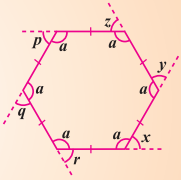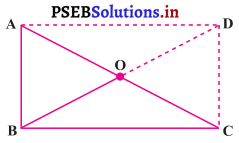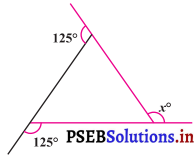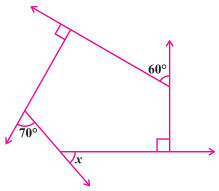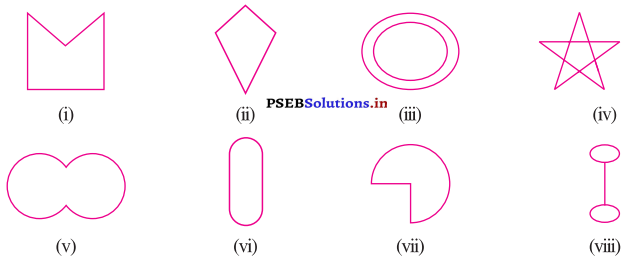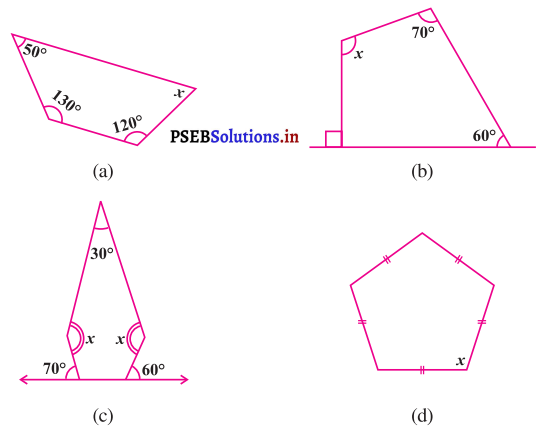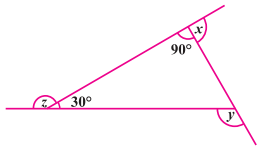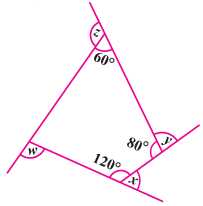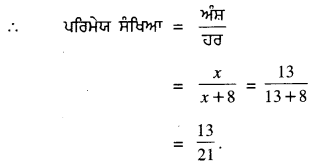Punjab State Board PSEB 8th Class Maths Book Solutions Chapter 4 ਪ੍ਰਯੋਗਿਕ ਜਿਆਮਿਤੀ Ex 4.1 Textbook Exercise Questions and Answers.
PSEB Solutions for Class 8 Maths Chapter 4 ਪ੍ਰਯੋਗਿਕ ਜਿਆਮਿਤੀ Exercise 4.1
1. ਹੇਠਾਂ ਲਿਖੇ ਚਤੁਰਭੁਜਾਂ ਦੀ ਰਚਨਾ ਕਰੋਂ :
ਪ੍ਰਸ਼ਨ (i).
ਚਤੁਰਭੁਜABCD ਜਿਸ ਵਿਚ
AB = 4.5 cm
BC = 5.5 cm
CD = 4 cm
AD = 6 cm
AC = 7 cm ਹੈ ।
ਹੱਲ:
ਦਿੱਤਾ ਹੈ : ਚਤੁਰਭੁਜ ਦੀਆਂ ਚਾਰ ਭੁਜਾਵਾਂ ਅਤੇ ਇਕ ਵਿਕਰਣ ਜਿਵੇਂ ਕਿ ਹੇਠਾਂ ਦਿੱਤਾ ਗਿਆ ਹੈ :
AB = 4.5 cm, BC = 5.5 cm, CD = 4 cm, AD = 6 cm, AC = 7 cm.
ਪਹਿਲਾ ਅਸੀਂ ਦਿੱਤੇ ਗਏ ਮਾਪਾਂ ਨੂੰ ਨਿਰੂਪਿਤ ਕਰਨ ਦੇ ਲਈ ਇਕ ਕੱਚੀ ਆਕ੍ਰਿਤੀ ਬਣਾਉਂਦੇ ਹਾਂ ।

ਰਚਨਾ ਦੇ ਪਗ :
(i) ਇਕ ਰੇਖਾਖੰਡ AC = 7 cm ਖਿੱਚੋ ।
(ii) A ਨੂੰ ਕੇਂਦਰ ਅਤੇ ਅਰਧ ਵਿਆਸ AD = 6 cm ਲੈ ਕੇ ਇਕ ਚਾਪ ਖਿੱਚੋ ।
(iii) c ਨੂੰ ਕੇਂਦਰ ਅਤੇ ਅਰਧ ਵਿਆਸ CD = 4 cm ਲੈ ਕੇ ਇਕ ਦੂਸਰੀ ਚਾਪ ਖਿੱਚੋ ਅ ਜੋ ਪਹਿਲੀ ਚਾਪ ਨੂੰ D ਬਿੰਦੂ ਉੱਤੇ ਕੱਟੇ ।
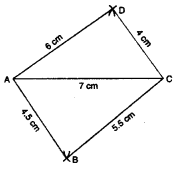
(iv) AD ਅਤੇ CD ਨੂੰ ਮਿਲਾਉ ।
(y) A ਨੂੰ ਕੇਂਦਰ ਅਤੇ ਅਰਧ ਵਿਆਸ AB = 4.5 cm, ਲੈ ਕੇ ਇਕ ਚਾਪ ਖਿੱਚੋ ।
(vi C ਨੂੰ ਕੇਂਦਰ ਅਤੇ ਅਰਧ ਵਿਆਸ BC = 5.5 cm, ਲੈ ਕੇ ਇਕ ਦੁਸਰੀ ਚਾਪ ਖਿੱਚੋ ਜੋ ਪਹਿਲੀ ਚਾਪ ਨੂੰ B ਉੱਤੇ ਕੱਟੇ ।
(vii) AB ਅਤੇ BC ਨੂੰ ਮਿਲਾਉ ॥
ਤਾਂ, ABCD ਲੋੜੀਦੀ ਚਤੁਰਭੁਜੇ ਹੈ ।
ਪ੍ਰਸ਼ਨ (ii).
ਚਤੁਰਭੁਜ JUMP ਜਿਸ ਵਿਚ
JU = 3.5 cm
UM = 4 cm
MP = 5 cm
PJ = 45 cm
PU = 6.5 cm ਹੈ ।
ਹੱਲ:
ਦਿੱਤਾ ਹੈ : ਚਤੁਰਭੁਜ ਦੀਆਂ ਚਾਰ ਭੁਜਾਵਾਂ ਅਤੇ ਇਕ ਵਿਕਰਣ ਇਸ ਤਰ੍ਹਾਂ ਦਿੱਤਾ ਗਿਆ ਹੈ :
JU = 3.5 cm, UM = 4 cm, MP = 5 cm, PJ = 4.5 cm, PU = 6.5 cm.
ਪਹਿਲਾਂ ਅਸੀਂ, ਦਿੱਤੇ ਗਏ ਅੰਕੜਿਆਂ ਨੂੰ ਨਿਰੂਪਿਤ ਕਰਨ ਲਈ ਇਕ ਕੱਚੀ ਆਕ੍ਰਿਤੀ ਬਣਾਉਂਦੇ ਹਾਂ ।

ਰਚਨਾ ਦੇ ਪਗ :
(i) ਇਕ ਰੇਖਾਖੰਡ PU = 6.5 cm ਲਉ ।
(ii) P ਨੂੰ ਕੇਂਦਰ ਅਤੇ ਅਰਧ ਵਿਆਸ P] =4.5 cm, ਲੈ ਕੇ ਇਕ ਚਾਪ ਖਿੱਚੋ ।
(iii) U ਨੂੰ ਕੇਂਦਰ ਅਤੇ ਅਰਧ ਵਿਆਸ UJ = 3.5 cm, | ਲੈ ਕੇ ਇਕ ਦੂਸਰੀ ਚਾਪ ਖਿੱਚੋ ਜੋ ਪਹਿਲੀ ਚਾਪ ਨੂੰ J ‘ਤੇ ਕੱਟੇ ।
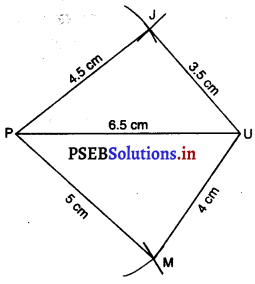
(iv) PJ ਅਤੇ JU ਨੂੰ ਮਿਲਾਉ ॥
(v) P ਨੂੰ ਕੇਂਦਰ ਅਤੇ ਅਰਧ ਵਿਆਸ PM = 5 cm, ਲੈ ਕੇ ਇਕ ਚਾਪ ਖਿੱਚੋ ।
(vi) U ਨੂੰ ਕੇਂਦਰ ਅਤੇ ਅਰਧ ਵਿਆਸ UM = 4 cm ਲੈ ਕੇ ਇਕ ਦੁਸਰੀ ਚਾਪ ਖਿੱਚੋ । ਜੋ ਪਹਿਲੀ ਚਾਪ ਨੂੰ M ਉਤੇ ਕੱਟੇ ।
(vii) PM ਅਤੇ UM ਨੂੰ ਮਿਲਾਉ,
ਤਾਂ JUMP ਲੋੜੀਂਦੀ ਚਤੁਰਭੁਜ, ਹੈ |
![]()
ਪ੍ਰਸ਼ਨ (iii).
ਸਮਾਂਤਰ ਚਤੁਰਭੁਜ MORE ਜਿਸ ਵਿਚ
OR = 6 cm
RE = 4.5 cm
EO : 7.5 cm ਹੈ ।
ਹੱਲ:
ਦਿੱਤਾ ਹੈ : ਸਮਾਂਤਰ ਚਤੁਰਭੁਜ ਦੀਆਂ ਸੰਗਤ ਭੁਜਾਵਾਂ ਅਤੇ ਇਕ ਵਿਕਰਣ ਇਸ ਤਰ੍ਹਾਂ ਹੈ ।
OR = 6 cm, RE = 4.5 cm ਅਤੇ EO = 7.5 cm.
ਰਚਨਾ ਦੇ ਪਗ :
(i) ਇਕ ਰੇਖਾਖੰਡ OE = 7.5 cm ਲਉ ।
(ii) O ਨੂੰ ਕੇਂਦਰ ਅਤੇ ਅਰਧ ਵਿਆਸ OR = 6 cm ਲੈ ਕੇ ਇਕ ਚਾਪ ਖਿੱਚੋ ।
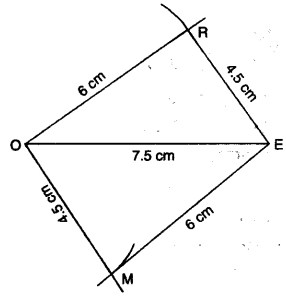
(iii) E ਨੂੰ ਕੇਂਦਰ ਅਤੇ ਅਰਧ ਵਿਆਸ ER =4.5 cm ਲੈ ਕੇ ਇਕ ਦੂਸਰੀ ਚਾਪ ਖਿੱਚੋ ਜੋ ਪਹਿਲੀ ਚਾਪ ਨੂੰ Rਉੱਤੇ ਕੱਟੇ ।
(iv) OR ਅਤੇ ER ਨੂੰ ਮਿਲਾਉ ॥
(v) O ਨੂੰ ਕੇਂਦਰ ਅਤੇ ਅਰਧ ਵਿਆਸ OM = 4.5 cm, ਲੈ ਕੇ ਇਕ ਚਾਪ ਖਿੱਚੋ ।
(vi) E ਨੂੰ ਕੇਂਦਰ ਅਤੇ ਅਰਧ ਵਿਆਸ EM = 6 cm ਲੈ ਕੇ ਇਕ ਦੁਸਰੀ ਚਾਪ ਖਿੱਚੋ ਜੋ ਪਹਿਲੀ ਚਾਪ ਨੂੰ M ਉੱਤੇ ਕੱਟੇ ।
(vii) OM ਅਤੇ EM ਨੂੰ ਮਿਲਾਉ ।
ਤਾਂ, MORE ਲੋੜੀਂਦੀ ਸਮਾਂਤਰ ਚਤੁਰਭੁਜ ਹੈ ।
![]()
ਪ੍ਰਸ਼ਨ (iv).
ਸਮ ਚਤੁਰਭੁਜ BEST ਜਿਸ ਵਿਚ
BE = 4.5 cm ਅਤੇ
ET : 6 cm ਹੈ ।
ਹੱਲ:
ਦਿੱਤਾ ਹੈ : ਮੰਨ ਲਉ ਕਿ ਬਣਾਈ ਜਾਣ ਵਾਲੀ ਸਮ ਚਤੁਰਭੁਜ BEST ਵਿਚ, BE = ES = ST = TB = 4.5 cm ਅਤੇ ਵਿਕਰਣ ET = 6 cm ਹੈ !
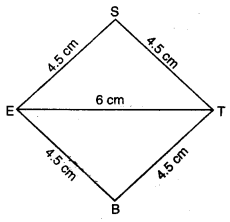
ਪਹਿਲਾਂ ਅਸੀਂ ਦਿੱਤੇ ਗਏ ਮਾਪ ਨਾਲ ਕੱਚੀ ਆਕ੍ਰਿਤੀ ਬਣਾਉਂਦੇ ਹਾਂ ।
ਰਚਨਾ ਦੇ ਪਗ :
(i) ਇਕ ਰੇਖਾ ਖੰਡ ET = 6 cm ਲਉ ।
(ii) E ਨੂੰ ਕੇਂਦਰ ਅਤੇ ਅਰਧ ਵਿਆਸ ES = EB = 4.5 cm, ਲੈ ਕੇ ਭੁਜਾ ET ਦੇ ਉੱਪਰ ਅਤੇ ਹੇਠਾਂ ਦੋ ਚਾਪਾਂ ਖਿੱਚੋ ।

(iii) T ਨੂੰ ਕੇਂਦਰ ਅਤੇ ਅਰਧ ਵਿਆਸ TS = TB =4.5 cm, ਲੈ ਕੇ ਚਾਪ ਖਿੱਚੋ ਜੋ ਪਗ (ii) ਦੀਆਂ ਚਾਪਾਂ ਨੂੰ ਕ੍ਰਮਵਾਰ S ਅਤੇ B ਉੱਤੇ ਕੱਟੇ । (iv) ES, ST, BE ਅਤੇ BT ਨੂੰ ਮਿਲਾਉ ।
ਤਾਂ, BEST ਲੋੜੀਂਦੀ ਸਮਚਤੁਰਭੁਜ ਹੈ ।

